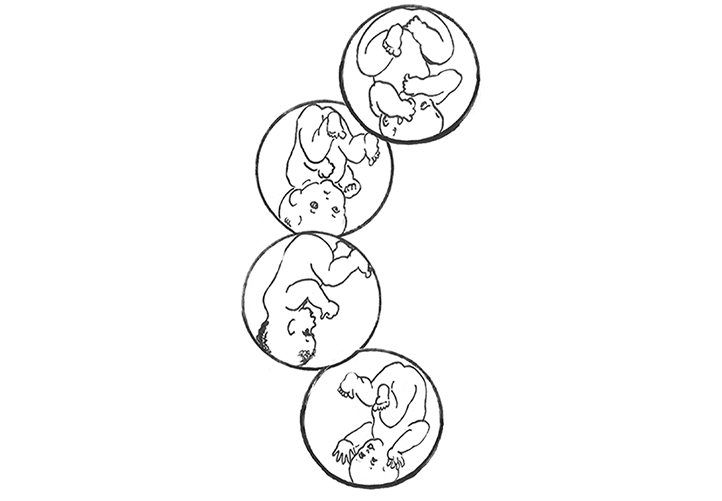
“I am almost 36 weeks pregnant with my second baby. My first son was born naturally, with no pain relief, no intervention and no instruments, after a 30-hour labour. It was very difficult but we pulled through and he was a very healthy newborn. He was average size (3.7kg). He had been LOA throughout the final months of pregnancy and was born LOA. I did a lot of positioning work then.
I would like to repeat that experience but am disheartened by the fact that the current baby has been completely posterior since week 33/34. He was LOA at the 33-week check, then in the following days I noticed he had shifted and I was having constant back pain that I had never had before in either pregnancy (pressure in the back). Then at the 34-week check he was confirmed posterior.
I stand or walk for most of the day. I don’t slouch on the sofa. When I sit my bump hangs forward.
I am concerned that when I go on all fours I am effectively doing an inversion and risk turning the baby breech. I feel that if I remain upright, the shape of my bump should by itself facilitate an anterior position. I don’t understand why the baby has turned posterior. I haven’t had back pain again so it doesn’t seem like he is trying to turn back at all.
I am terrified of a posterior labour. I don’t think I can handle anything worse than what I had last time, and that was with LOA. I have lost all confidence in my ability to have a natural birth. I would be very grateful for your advice.”
You are facing a common dilemma. The second labor after a first, long labor.
Remember, most women having posterior labors have progressing and do-able labors. First of all, babies come out. You’ve done it before and you can do it again. There is an illusion that medicated birth is painless, shorter, etc. It’s just different, it may be easier, but of course, most 2nd births are going to be easier anyway.
There are common mistakes about what to do to help a baby into a good starting position for labor. Maternal positioning is only the second of 3 Principles, please visit the discussion of the Three Principles on my Pregnancy page.
You are not at all doing an Inversion when you are on all-fours. The Inversion is a wonderful tool when used as shown in this video. Limiting the time you do the inversion will prevent the baby going breech. But you can do it daily for a short period of time, as shown in the video. Do not do the Inversion if your doctor or midwife has said that there is more amniotic fluid than usual (for instance, you measure 3 or more cms over dates).
The shape of your abdomen, your bump, as you call it, is not a reliable indicator of fetal position. Nor will it make your baby be anterior. You can try adding a pregnancy belt to see if that helps baby rotate, but I suggest body work. Myofascial work on your broad and round ligaments. Meanwhile, repeated Inversions will eventually help the broad and round ligaments as your pelvis comes into symmetry over time and repetition.
Do you have a doula who is mature and calm? I’ve helped many women, as a doula and as a midwife, with just your situation. Very often their labors are delightfully shorter than the first, in spite of having a posterior baby the second time.
You don’t have to start with an anterior baby, you have to start with a tucked chin. It also helps to have a relaxed pelvis, pelvic floor muscles, and uterine ligaments and be moving with your labor, in positions that help the uterus line up with your pelvis. You can do that with the Inversion, Chiropractic and the Pelvic Floor Release.
You may have to face the fear of a 30-hour labor again so you can get past that and get on with a second labor. The real labor. Not the labor in your mind. There is only room for one head in your pelvis, and it isn’t yours. Once you do that, you can enjoy the wonder of this child and this remarkable journey you are on.
How do you want to remember this pregnancy? Let go and find some joy here. I will try and follow this advice in my day today while I hold you in my heart and trust that you will find your way. I know you can. Have a brave and wonderful birth.
[tribe_events_list limit=”4″]